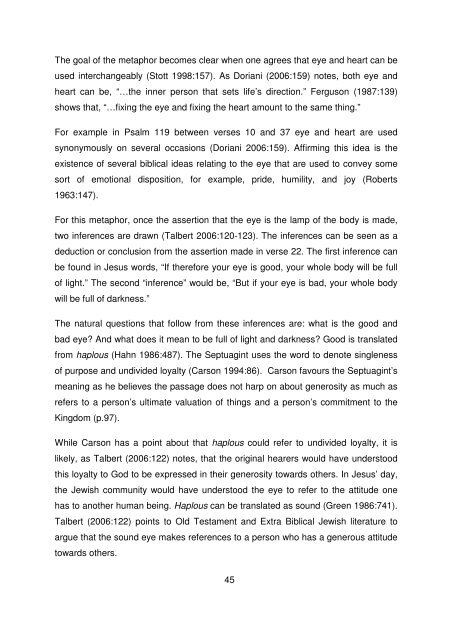O'Donoghue MTh_Thesis-FinalCopy.pdf - South African Theological ...
O'Donoghue MTh_Thesis-FinalCopy.pdf - South African Theological ...
O'Donoghue MTh_Thesis-FinalCopy.pdf - South African Theological ...
You also want an ePaper? Increase the reach of your titles
YUMPU automatically turns print PDFs into web optimized ePapers that Google loves.
The goal of the metaphor becomes clear when one agrees that eye and heart can beused interchangeably (Stott 1998:157). As Doriani (2006:159) notes, both eye andheart can be, “…the inner person that sets life’s direction.” Ferguson (1987:139)shows that, “…fixing the eye and fixing the heart amount to the same thing.”For example in Psalm 119 between verses 10 and 37 eye and heart are usedsynonymously on several occasions (Doriani 2006:159). Affirming this idea is theexistence of several biblical ideas relating to the eye that are used to convey somesort of emotional disposition, for example, pride, humility, and joy (Roberts1963:147).For this metaphor, once the assertion that the eye is the lamp of the body is made,two inferences are drawn (Talbert 2006:120-123). The inferences can be seen as adeduction or conclusion from the assertion made in verse 22. The first inference canbe found in Jesus words, “If therefore your eye is good, your whole body will be fullof light.” The second “inference” would be, “But if your eye is bad, your whole bodywill be full of darkness.”The natural questions that follow from these inferences are: what is the good andbad eye? And what does it mean to be full of light and darkness? Good is translatedfrom haplous (Hahn 1986:487). The Septuagint uses the word to denote singlenessof purpose and undivided loyalty (Carson 1994:86). Carson favours the Septuagint’smeaning as he believes the passage does not harp on about generosity as much asrefers to a person’s ultimate valuation of things and a person’s commitment to theKingdom (p.97).While Carson has a point about that haplous could refer to undivided loyalty, it islikely, as Talbert (2006:122) notes, that the original hearers would have understoodthis loyalty to God to be expressed in their generosity towards others. In Jesus’ day,the Jewish community would have understood the eye to refer to the attitude onehas to another human being. Haplous can be translated as sound (Green 1986:741).Talbert (2006:122) points to Old Testament and Extra Biblical Jewish literature toargue that the sound eye makes references to a person who has a generous attitudetowards others.45
















